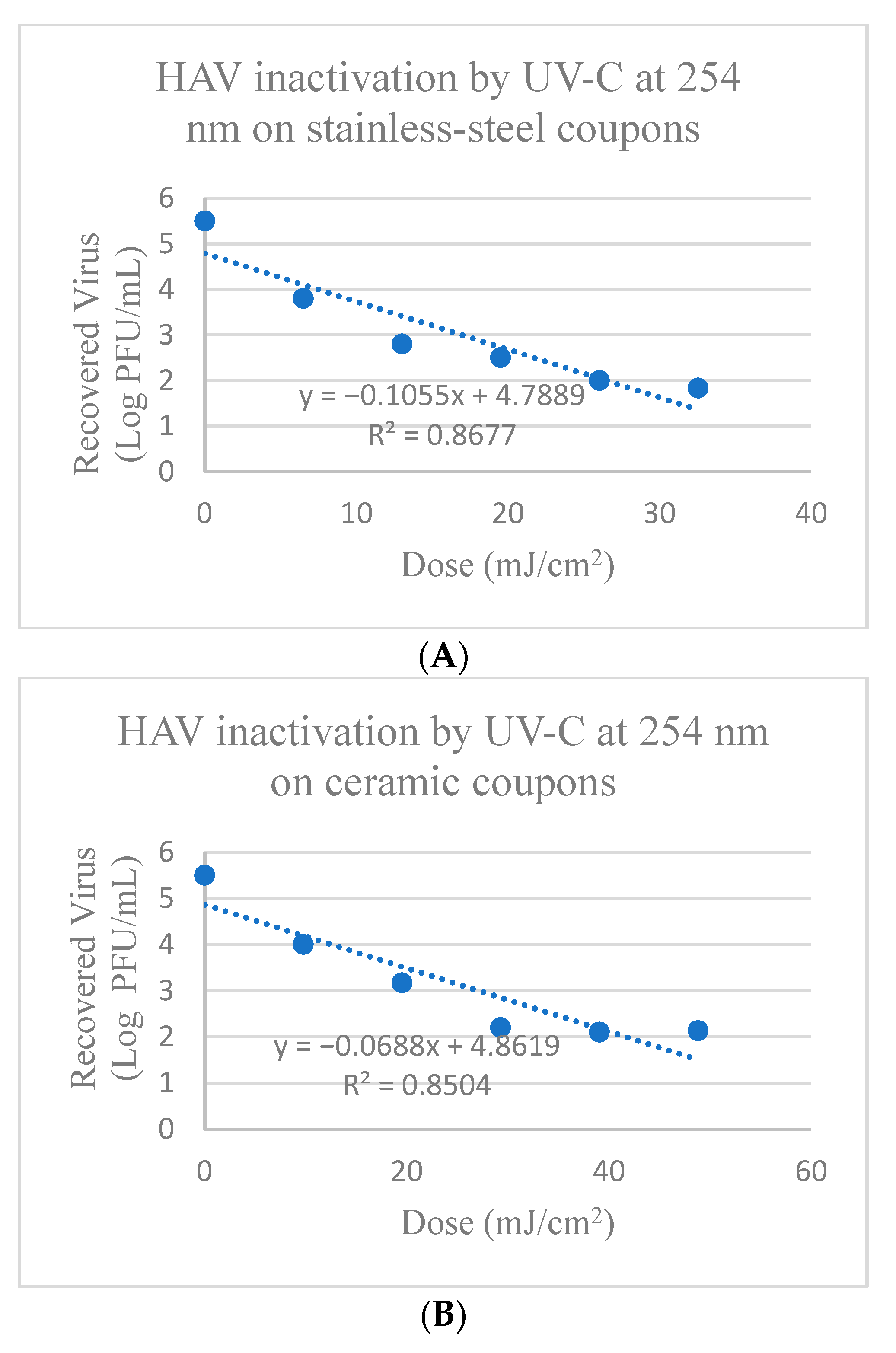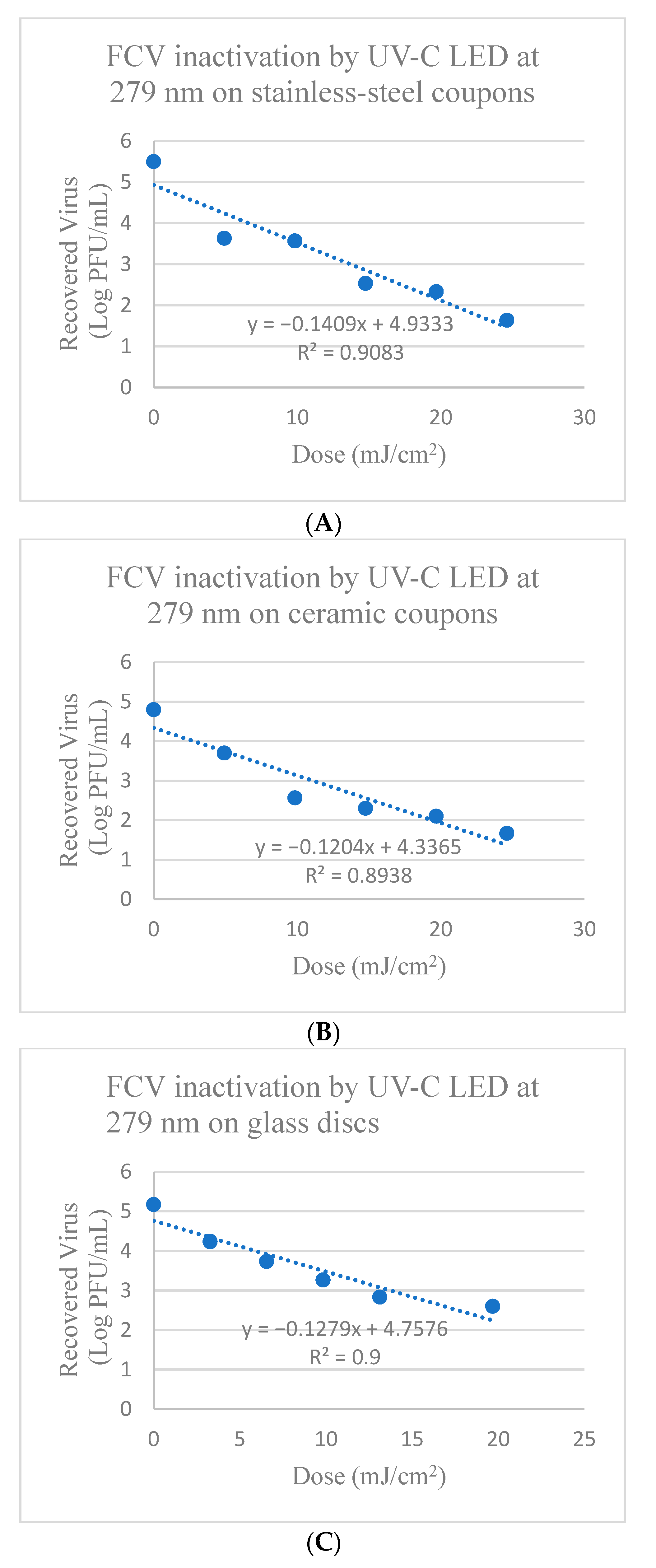Inactivation of Hepatitis A Virus and Feline Calicivirus on Model Food Contact Surfaces by Ultraviolet Light (UV-C) Systems
Abstract
1. Introduction
2. Materials and Methods
2.1. Animal Host Cell Lines for HAV and FCV Propagation
2.2. HAV and FCV Propagation
2.3. UV-C LED (279 nm) Treatment of HAV and FCV Inoculated and Dried on Stainless-Steel Coupons, Ceramic Coupons, and Glass Discs
2.4. UV-C (254 nm) Treatment of HAV and FCV Inoculated and Dried on Stainless-Steel Coupons, Ceramic Coupons and Glass Discs
2.5. Infectious Plaque Assays
2.6. UV-C Dose Calculation
2.7. Surface Roughness Measurements
2.8. Statistical Analysis
3. Results
3.1. Inactivation of HAV and FCV on Stainless-Steel Coupons Using UV-C at 254 nm
3.2. Inactivation of HAV and FCV on Ceramic Coupons Using UV-C at 254 nm
3.3. Inactivation of HAV and FCV on Glass Discs Using UV-C at 254 nm
3.4. Inactivation of HAV and FCV on Stainless-Steel Coupons Using UV-C at 279 nm
3.5. Inactivation of HAV and FCV on Ceramic Coupons Using UV-C at 279 nm
3.6. Inactivation of HAV and FCV on Glass Discs Using UV-C at 279 nm
3.7. Surface Roughness (Ra) Measurements of Each Model Surface
4. Discussion
5. Conclusions
Supplementary Materials
Author Contributions
Funding
Data Availability Statement
Conflicts of Interest
References
- Centers for Disease Control and Prevention (CDC). Reports of Salmonella in the United States. Available online: https://www.cdc.gov/salmonella/index.html (accessed on 20 August 2024).
- Centers for Disease Control and Prevention (CDC). Person-to-person outbreaks of hepatitis A across the United States. Available online: https://www.cdc.gov/hepatitis/outbreaks/ongoing-hepatitis-a/index.html (accessed on 20 August 2024).
- Stuart, D.I.; Ren, J.; Wang, X.; Rao, Z.; Fry, E.E. Hepatitis A Virus Capsid Structure. Cold Spring Harb. Perspect. Med. 2019, 9, a031807. [Google Scholar] [CrossRef] [PubMed]
- Sattar, S.A.; Jason, T.; Bidawid, S.; Farber, J. Foodborne spread of hepatitis A: Recent studies on virus survival, transfer and inactivation. Can. J. Infect. Dis. 2000, 11, 159–163. [Google Scholar] [CrossRef] [PubMed]
- Shin, E.C.; Jeong, S.H. Natural History, Clinical Manifestations, and Pathogenesis of Hepatitis A. Cold Spring Harb. Perspect. Med. 2018, 8, a031708. [Google Scholar] [CrossRef] [PubMed]
- Foster, M.A.; Hofmeister, M.G.; Kupronis, B.A.; Lin, Y.; Xia, G.L.; Yin, S.; Teshale, E. Increase in Hepatitis A Virus Infections—United States, 2013-2018. MMWR Morb. Mortal. Wkly. Rep. 2019, 68, 413–415. [Google Scholar] [CrossRef]
- Centers for Disease Control and Prevention (CDC). Burden of Norovirus in the United States. Available online: https://www.cdc.gov/norovirus/data-research/index.html (accessed on 20 August 2024).
- Graaf, M.; Beek, J.; Koopmans, M.P. Human norovirus transmission and evolution in a changing world. Nat. Rev. Microbiol. 2016, 14, 421–433. [Google Scholar] [CrossRef]
- Debbink, K.; Lindesmith, L.C.; Ferris, M.T.; Swanstrom, J.; Beltramello, M.; Corti, D.; Lanzavecchia, A.; Baric, R.S. Within-host evolution results in antigenically distinct GII.4 noroviruses. J. Virol. 2014, 88, 7244–7255. [Google Scholar] [CrossRef]
- Araud, E.; Fuzawa, M.; Shisler, J.L.; Li, J.; Nguyen, T.H. UV Inactivation of Rotavirus and Tulane Virus Targets Different components of the virions. Appl. Environ. Microbiol. 2020, 86, e02436-19. [Google Scholar] [CrossRef] [PubMed]
- Joshi, S.S.; Dice, L.; Ailavadi, S.; D’Souza, D.H. Antiviral Effects of Quillaja saponaria Extracts Against Human Noroviral Surrogates. Food Environ. Virol. 2023, 15, 167–175. [Google Scholar] [CrossRef]
- Patwardhan, M.; Morgan, M.T.; Dia, V.; D’Souza, D.H. Heat sensitization of hepatitis A virus and Tulane virus using grape seed extract, gingerol and curcumin. Food Microbiol. 2020, 90, 103461. [Google Scholar] [CrossRef]
- Dubuis, M.E.; Dumont-Leblond, N.; Laliberté, C.; Veillette, M.; Turgeon, N.; Jean, J.; Duchaine, C. Ozone efficacy for the control of airborne viruses: Bacteriophage and norovirus models. PLoS ONE 2020, 15, 0231164. [Google Scholar]
- Huang, J.; Park, G.W.; Jones, R.M.; Fraser, A.M.; Vinjé, J.; Jiang, X. Efficacy of EPA-registered disinfectants against two human norovirus surrogates and Clostridioides difficile endospores. J. Appl. Microbiol. 2022, 132, 4289–4299. [Google Scholar] [CrossRef] [PubMed]
- Ao, X.W.; Eloranta, J.; Huang, C.H.; Santoro, D.; Sun, W.J.; Lu, Z.D.; Li, C. Peracetic acid-based advanced oxidation processes for decontamination and disinfection of water: A review. Water Res. 2021, 188, 116479. [Google Scholar] [CrossRef] [PubMed]
- Balamurugan, S.; Zaidi, M.; Arvaj, L.; Pendyala, B.; Gabriel, M.; Farber, J.M.; Sasges, M.; Patras, A. Modeling the UV-C Inactivation Kinetics and Determination of Fluence Required for Incremental Inactivation of Cronobacter spp. J. Food Prot. 2022, 85, 1625–1634. [Google Scholar] [CrossRef] [PubMed]
- Vashisht, P.; Pendyala, B.; Gopisetty, V.V.S.; Patras, A. Modeling and validation of delivered fluence of a continuous Dean flow pilot scale UV system: Monitoring fluence by biodosimetry approach. Food Res. Int. 2021, 148, 110625. [Google Scholar] [CrossRef]
- Sadraeian, M.; Zhang, L.; Aavani, F. Viral inactivation by light. eLight 2022, 2, 18. [Google Scholar] [CrossRef]
- Gómez-López, V.M.; Jubinville, E.; Rodríguez-López, M.I.; Trudel-Ferland, M.; Bouchard, S.; Jean, J. Inactivation of Foodborne Viruses by UV Light: A Review. Foods 2021, 10, 3141. [Google Scholar] [CrossRef]
- Nuanualsuwan, S.; Mariam, T.; Himathongkham, S.; Cliver, D.O. Ultraviolet Inactivation of Feline Calicivirus, Human EntericViruses and Coliphages. Photochem. Photobiol. 2002, 76, 406–410. [Google Scholar] [CrossRef]
- Moldgy, A. Comparative Evaluation of the Virucidal Effect of Remote and Direct Cold Air Plasmas with UV-C. Plasma Process. Polym. 2020, 17, 1900234. [Google Scholar] [CrossRef]
- Park, S.Y.; Kim, A.N.; Lee, K.H.; Ha, S.D. Ultraviolet-C efficacy against a norovirus surrogate and hepatitis A virus on a stainless-steel surface. Int. J. Food Microbiol. 2015, 211, 73–78. [Google Scholar] [CrossRef]
- Schöbel, H.; Diem, G.; Kiechl, J.; Chistè, D.; Bertacchi, G.; Mayr, A.; Posch, W. Antimicrobial efficacy and inactivation kinetics of a novel LED-based UV-irradiation technology. J. Hosp. Infect. 2023, 135, 11–17. [Google Scholar] [CrossRef]
- Sharma, A.; Mahmoud, H.; Pendyala, B.; Balamurugan, S.; Patras, A. UV-C inactivation of microorganisms in droplets on food contact surfaces using UV-C light-emitting diode devices. Front. Food Sci. Technol. 2023, 3, 1182765. [Google Scholar] [CrossRef]
- Pendyala, B.; Patras, A.; Pokharel, B.; D’Souza, D. Genomic Modeling as an Approach to Identify Surrogates for Use in Experimental Validation of SARS-CoV-2 and HuNoV Inactivation by UV-C Treatment. Front. Microbiol. 2020, 29, 572331. [Google Scholar] [CrossRef] [PubMed]
- Kheyrandish, A.; Mohseni, M.; Taghipour, F. Protocol for Determining Ultraviolet Light Emitting Diode (UV-LED) Fluence for Microbial Inactivation Studies. Environ. Sci. Technol. 2018, 52, 7390–7398. [Google Scholar] [CrossRef] [PubMed]
- Mariita, R.M.; Wilson Miller, A.C.; Randive, R.V. Evaluation of the virucidal efficacy of Klaran UVC LEDs against surface-dried norovirus. Access Microbiol. 2022, 4, 000323. [Google Scholar] [CrossRef] [PubMed]
- Corson, E.; Pendyala, B.; Patras, A.; D’Souza, D.H. Inactivation of hepatitis A virus, feline calicivirus, and Tulane virus on Formica coupons using ultraviolet light technologies. Heliyon 2024, 10, e25201. [Google Scholar] [CrossRef]
- Choi, J.M.; D’Souza, D.H. Inactivation of Tulane virus and feline calicivirus by aqueous ozone. J. Food Sci. 2023, 88, 4218–4229. [Google Scholar] [CrossRef]
- Bozkurt, H.; D’Souza, D.H.; Davidson, P.M. Determination of thermal inactivation kinetics of hepatitis A virus in blue mussel (Mytilus edulis) homogenate. Appl. Environ. Microbiol. 2014, 80, 3191–3197. [Google Scholar] [CrossRef]
- Baldelli, G.; Aliano, M.P.; Amagliani, G.; Magnani, M.; Brandi, G.; Pennino, C.; Schiavano, G.F. Airborne microorganism inactivation by a UV-C LED and ionizer-based continuous sanitation air (CSA) system in train environments. Int. J. Environ. 2022, 19, 1559. [Google Scholar] [CrossRef]
- Sharma, A.; Singh, A.; Pendyala, B.; Balamurugan, S.; Patras, A. Inactivation of Deposited Bioaerosols on Food Contact Surfaces with UV-C Light Emitting Diode Devices. 2024, to be submitted. [CrossRef]
- Stein, R.A.; Chirilã, M. Routes of Transmission in the Food Chain. In Foodborne Diseases; Academic Press: Cambridge, MA, USA, 2017; pp. 65–103. [Google Scholar] [CrossRef]
- Lim, W.; Harrison, M.A. Effectiveness of UV light as a means to reduce Salmonella contamination on tomatoes and food contact surfaces. Food Control 2016, 66, 166–173. [Google Scholar] [CrossRef]
- Yaun, B.R.; Sumner, S.S.; Eifert, J.D.; Marcy, J.E. Inhibition of pathogens on fresh produce by ultraviolet energy. Int. J. Food Microbiol. 2004, 90, 1–8. [Google Scholar] [CrossRef]
- Kim, D.K.; Kang, D.H. Effect of surface characteristics on the bactericidal efficacy of UVC LEDs. Food Control 2020, 108, 106869. [Google Scholar] [CrossRef]
- Park, G.W.; Linden, K.G.; Sobsey, M.D. Inactivation of murine norovirus, feline calicivirus and echovirus 12 as surrogates for human norovirus (NoV) and coliphage (F+) MS2 by ultraviolet light (254 nm) and the effect of cell association on UV inactivation. Lett. Appl. Microbiol. 2011, 52, 162–167. [Google Scholar] [CrossRef] [PubMed]
- Tomás, A.L.; Reichel, A.; Silva, P.M.; Silva, P.G.; Pinto, J.; Calado, I.; Santos, N.C. UV-C irradiation-based inactivation of SARS-CoV-2 in contaminated porous and non-porous surfaces. J. Photochem. Photobiol. B Biol. 2022, 234, 112531. [Google Scholar] [CrossRef] [PubMed]
- Kim, S.J.; Kim, D.K.; Kang, D.H. Using UVC light-emitting diodes at wavelengths of 266 to 279 nanometers to inactivate foodborne pathogens and pasteurize sliced cheese. Appl. Environ. Microbiol. 2016, 82, 11–17. [Google Scholar] [CrossRef]
- Calle, A.; Fernandez, M.; Montoya, B.; Schmidt, M.; Thompson, J. UV-C LED Irradiation Reduces Salmonella on Chicken and Food Contact Surfaces. Foods 2021, 10, 1459. [Google Scholar] [CrossRef]






| Surface Type | UV-C LED System (279 nm) D10-Value (mJ/cm2) | UV-C LED System (279 nm) D-Value (min) | UV-C (254 nm) D10-Value (mJ/cm2) | UV-C (254 nm) D-Value (min) |
|---|---|---|---|---|
| Stainless-steel | 19.53 ± 2.45 Ab | 1.0 ± 0.12 Ab | 9.48 ± 0.34 Bb | 0.73 ± 0.03 Bb |
| Ceramic | 26.04 ± 0.60 Aa | 1.3 ± 0.03 Aa | 14.53 ± 2.52 Ba | 1.1 ± 0.12 Ba |
| Glass | 8.77 ± 2.08 Ac | 0.47 ± 0.11 Bc | 6.91 ± 1.93 Bb | 0.56 ± 0.16 Ab |
| Surface Type | UV-C LED System (279 nm) D10-Value (mJ/cm2) | UV-C LED System (279 nm) D-Value (min) | UV-C (254 nm) D10-Value (mJ/cm2) | UV-C (254 nm) D-Value (min) |
|---|---|---|---|---|
| Stainless-steel | 7.097 ± 2.11 Aa | 0.38 ± 0.11 Aa | 3.65 ± 0.06 Ba | 0.28 ± 0.001 Ba |
| Ceramic | 8.31 ± 2.12 Aa | 1.37 ± 0.34 Ba | 5.92 ± 1.90 Ba | 1.45 ± 0.48 Aa |
| Glass | 7.82 ± 0.86 Aa | 0.40 ± 0.05 Aa | 4.69 ± 0.03 Ba | 0.36 ± 0.001 Ba |
Disclaimer/Publisher’s Note: The statements, opinions and data contained in all publications are solely those of the individual author(s) and contributor(s) and not of MDPI and/or the editor(s). MDPI and/or the editor(s) disclaim responsibility for any injury to people or property resulting from any ideas, methods, instructions or products referred to in the content. |
© 2024 by the authors. Licensee MDPI, Basel, Switzerland. This article is an open access article distributed under the terms and conditions of the Creative Commons Attribution (CC BY) license (https://creativecommons.org/licenses/by/4.0/).
Share and Cite
Polen, B.; Pendyala, B.; Patras, A.; D’Souza, D.H. Inactivation of Hepatitis A Virus and Feline Calicivirus on Model Food Contact Surfaces by Ultraviolet Light (UV-C) Systems. Foods 2024, 13, 2892. https://doi.org/10.3390/foods13182892
Polen B, Pendyala B, Patras A, D’Souza DH. Inactivation of Hepatitis A Virus and Feline Calicivirus on Model Food Contact Surfaces by Ultraviolet Light (UV-C) Systems. Foods. 2024; 13(18):2892. https://doi.org/10.3390/foods13182892
Chicago/Turabian StylePolen, Breanna, Brahmaiah Pendyala, Ankit Patras, and Doris H. D’Souza. 2024. "Inactivation of Hepatitis A Virus and Feline Calicivirus on Model Food Contact Surfaces by Ultraviolet Light (UV-C) Systems" Foods 13, no. 18: 2892. https://doi.org/10.3390/foods13182892
APA StylePolen, B., Pendyala, B., Patras, A., & D’Souza, D. H. (2024). Inactivation of Hepatitis A Virus and Feline Calicivirus on Model Food Contact Surfaces by Ultraviolet Light (UV-C) Systems. Foods, 13(18), 2892. https://doi.org/10.3390/foods13182892






